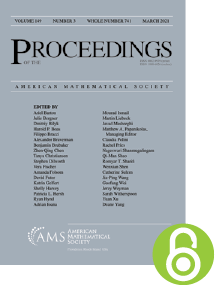Three counterexamples for a question concerning Green’s functions and circular symmetrization
HTML articles powered by AMS MathViewer
- by Alexander R. Pruss PDF
- Proc. Amer. Math. Soc. 124 (1996), 1755-1761 Request permission
Abstract:
We construct domains $U$ in the plane such that if $G(re^{i\theta })$ is the Green’s function of $U$ with pole at zero, while $\tilde G(r e^{i\theta })$ is the symmetric non-increasing rearrangement of $G(re^{i\theta })$ for each fixed $r$ and $G^{*}$ is the Green’s function of the circular symmetrization $U^{*}$, again with pole at zero, then there are positive numbers $r$ and $\varepsilon$ such that \begin{equation*}G^{*}(r e^{i\theta }) < \tilde G(r e^{i\theta }), \end{equation*} whenever $0<|\pi -\theta |<\varepsilon$. One of our constructions will have $U$ simply connected. We also consider the case where the poles of the Green’s functions do not lie at the origin. Our work provides a negative answer to a question of Hayman (1967).References
- Albert Baernstein II, Integral means, univalent functions and circular symmetrization, Acta Math. 133 (1974), 139–169. MR 417406, DOI 10.1007/BF02392144
- Arne Beurling, Études sur un problème de majoration, Thèse pour le doctorat, Almqvist & Wiksell, Uppsala, 1933.
- W. K. Hayman, Research problems in function theory, The Athlone Press [University of London], London, 1967. MR 0217268
- Rolf Nevanlinna, Analytic functions, Die Grundlehren der mathematischen Wissenschaften, Band 162, Springer-Verlag, New York-Berlin, 1970. Translated from the second German edition by Phillip Emig. MR 0279280
Additional Information
- Alexander R. Pruss
- Affiliation: University of British Columbia, Vancouver, British Columbia, Canada V6T 1Z2
- Email: pruss@math.ubc.ca
- Received by editor(s): September 30, 1994
- Received by editor(s) in revised form: November 16, 1994
- Additional Notes: The research was partially supported by Professor J. J. F. Fournier’s NSERC Grant #4822. This paper constitutes a portion of the author’s doctoral dissertation.
- Communicated by: Albert Baernstein II
- © Copyright 1996 American Mathematical Society
- Journal: Proc. Amer. Math. Soc. 124 (1996), 1755-1761
- MSC (1991): Primary 31A15
- DOI: https://doi.org/10.1090/S0002-9939-96-03196-6
- MathSciNet review: 1307558


